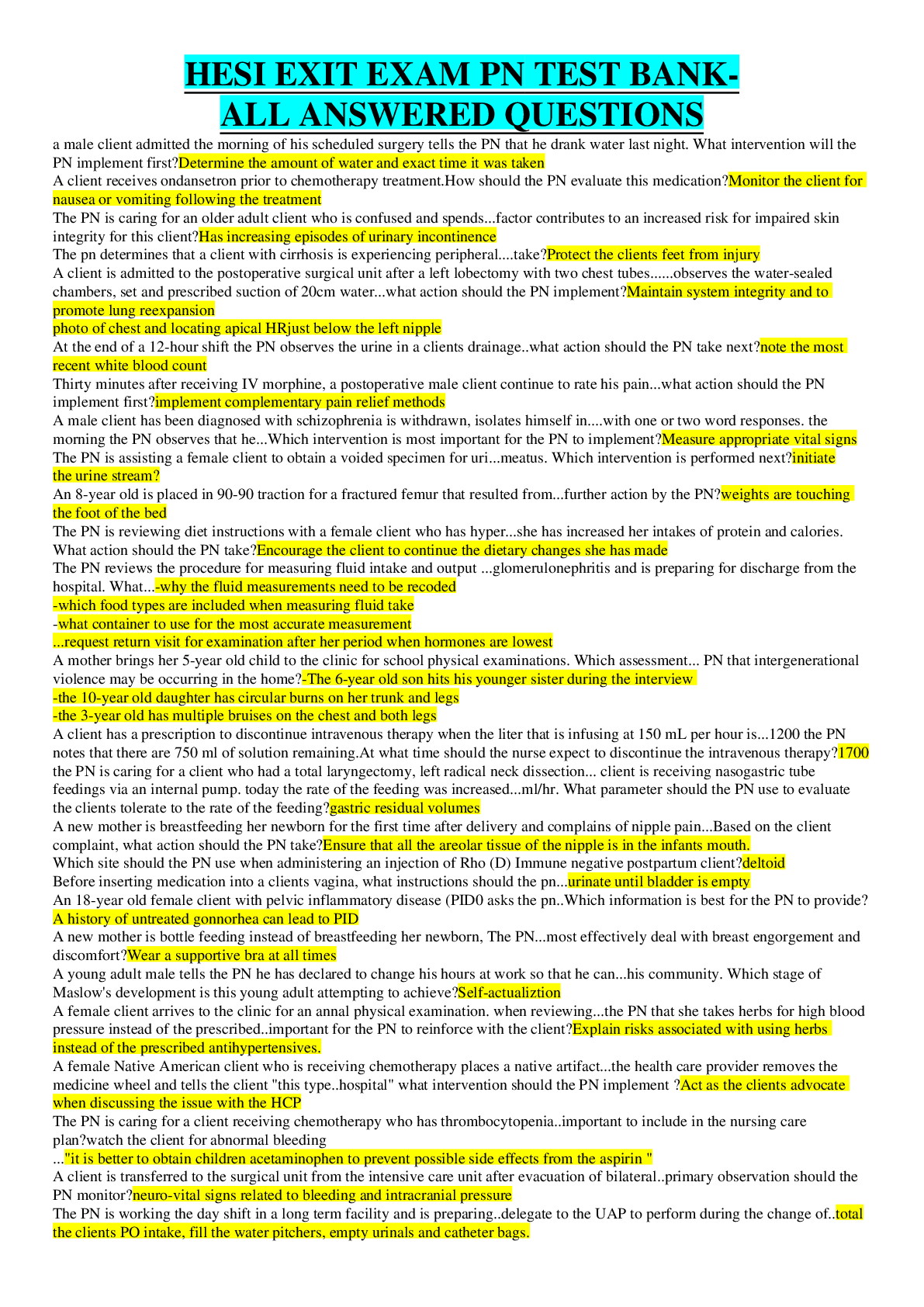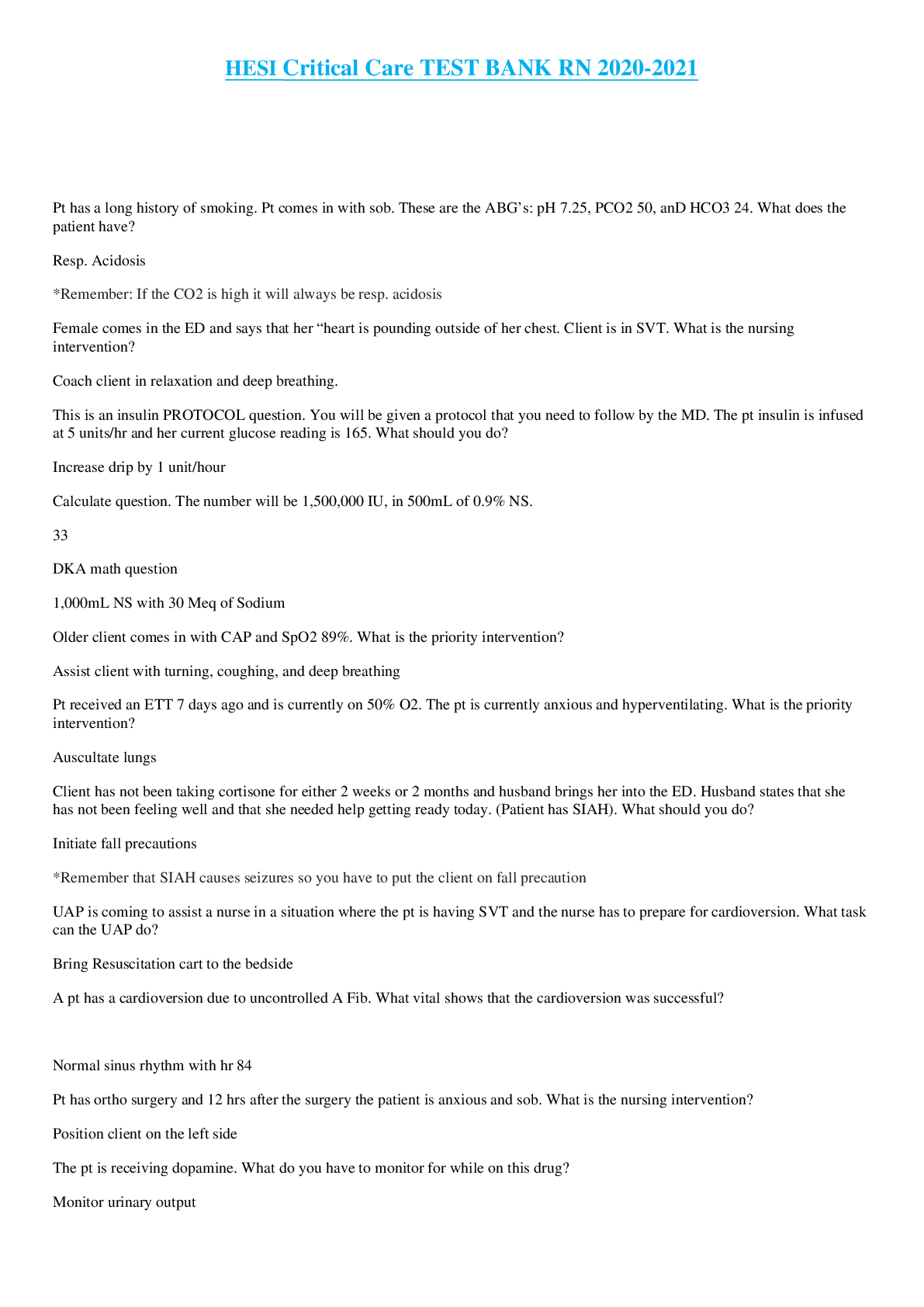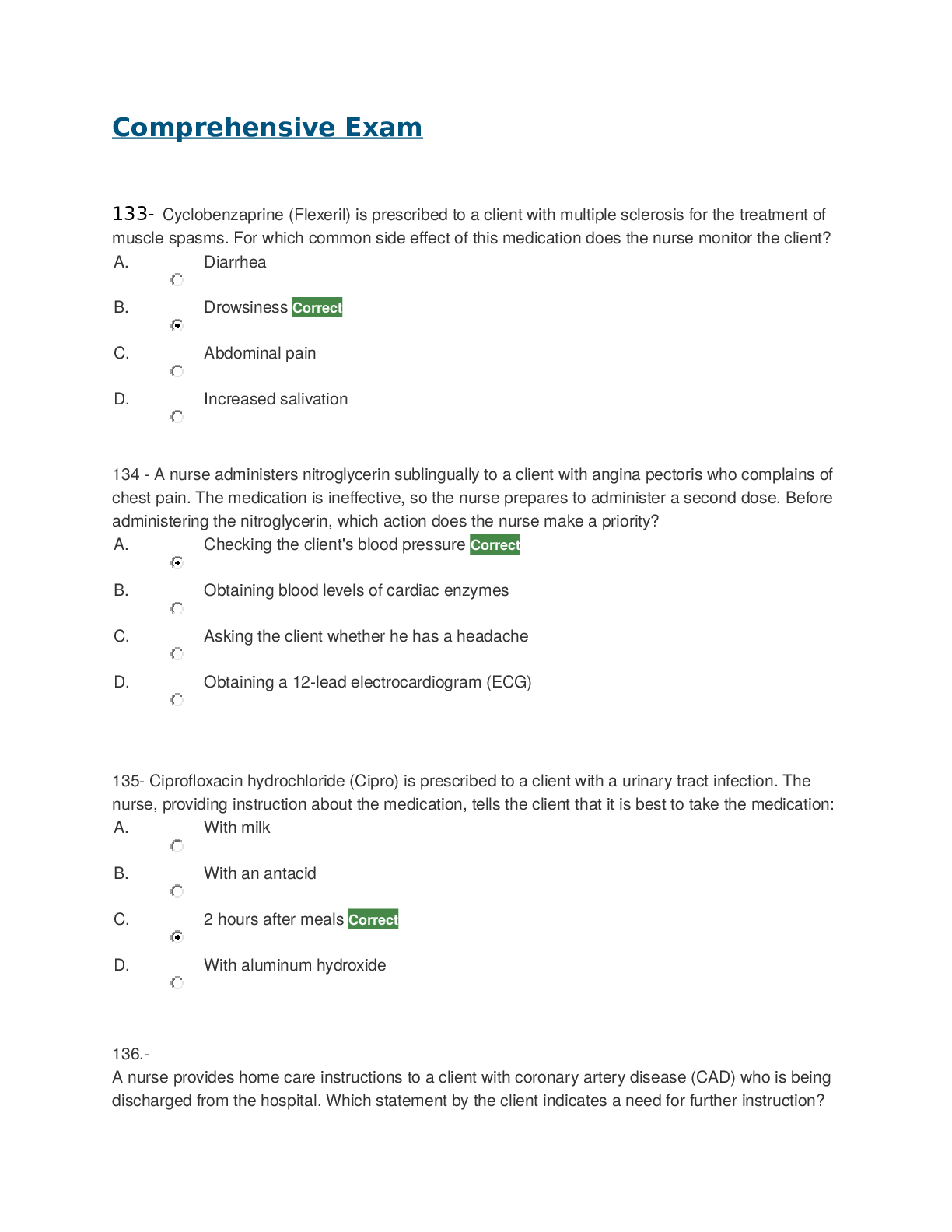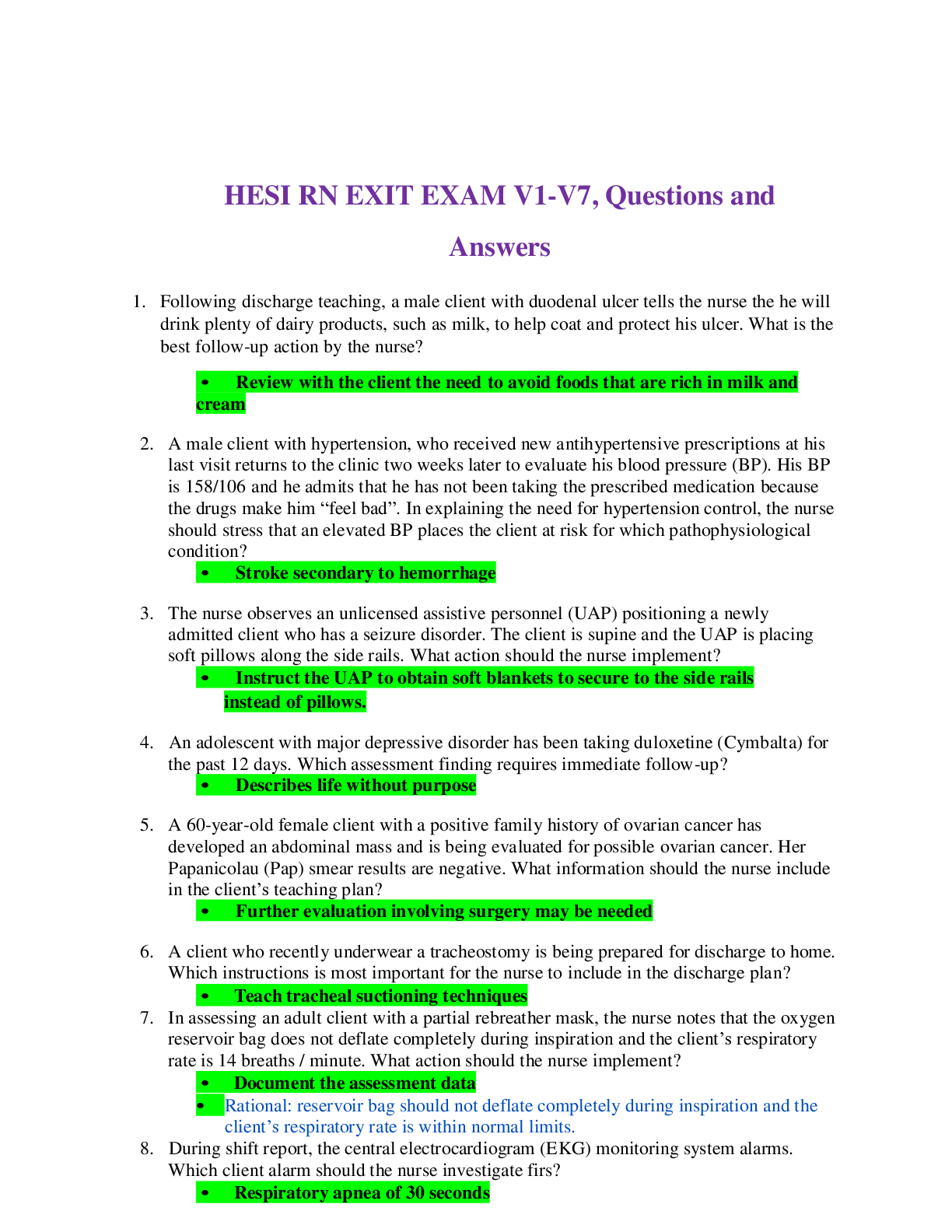Health Assessment Hesi Exam (GRADED A) Questions and Answers
Document Content and Description Below
Which of the following statements from a patient's history is it most important to investigate further? a. "I have an allergy to peanuts." b. "I have lost 30 pounds over the last 4 months." c... . "I don't like many vegetables so I take multivitamins." d. "I drink 2 cups of coffee each morning." ANS: B The statement in option "b is most important to investigate further because any significant weight loss may indicate a serious problem. The statement about an allergy to peanuts is not the most important piece of information, although the nurse would want to investigate and document any food allergies. Option "c" is not the most significant statement; however, the nurse should investigate the types and amounts of vegetables the patient eats. Two cups of coffee is considered fairly typical and the patient is not consuming an excessive amount of caffeine. Your patient complains of pruritus. You should examine the patient for which of the following associated signs and symptoms? a. rash and edema b. coolness and pallor c. cyanosis and coolness d. ecchymosis and purpura ANS: A Pruritus or itching of the skin is associated with the following manifestations: rashes, lesions, edema, angioedema, anaphylaxis, excoriation or ulcers as a result of scratching, lichenification or thickening of the skin, and systemic disease. As a result of scratching the skin due to pruritus, the skin would most likely be warm and red, not pale, cool, or cyanotic. Ecchymosis is a violaceous discoloration, also called a black-and-blue mark. Purpura is a condition characterized by the presence of confluent petechiae or confluent ecchymosis. Neither of these is associated with pruritus. ____ 3. Your patient asks you about the small, reddish purple discolorations of the skin, less than 0.5 cm in diameter. You inform the patient that this is known as which of the following? a. ecchymoses c. purpura b. petechiae d. spider telangiectasia ANS: B Petechiae are violaceous (red-purple) discolorations of less than 0.5 cm in diameter. Petechiae do not blanch. They can indicate an increased bleeding tendency or embolism; causes include intravascular defects and infections. Ecchymosis is a violaceous discoloration of varying size, also called a black-and-blue mark. It is caused by extravasation of blood into the skin as a result of trauma; heparin or Coumadin use; or liver dysfunction. Purpura is a condition characterized by the presence of confluent petechiae or confluent ecchymosis over any part of the body. Purpura is caused by hemorrhage into the skin and can be the result of decreased platelet formation. Spider angiomas, a type of telangiectasia, are bright red and star-shaped. Most often these lesions are found on the face, neck, and chest. There is often a central pulsation noted with pressure, and this results in blanching in the extensions. Your patient expresses concern about a mole on her right leg that has recently started itching. Which accompanying finding most likely indicates a developing cancerous lesion? a. regular and distinct border c. edema in both feet b. multiple colorations d. inflammation of periungual tissue ANS: B Developing cancerous lesions may have multiple colorations such as brownish, tan, red, white, blue, pink, purple, or gray. Other signs in potentially cancerous lesions include the following: 1) rapid change in size; 2) change in coloration; 3) irregular or butterfly-shaped border; 4) elevation in a previously flat mole; 5) multiple colorations in a lesion; 6) change in surface characteristics, such as oozing; 7) change in sensation, such as pain, itching, or tenderness; 8) change in surrounding skin, such as inflammation or induration; and 9) bleeding or ulcerative appearance in a mole. These lesions are not associated with edema or inflammation of the area around the fingernails or the toenails. After releasing the pressure of your thumb on your patient's lower legs, ankles, and feet, you observe a 4 mm depression of the skin that disappears in 10 to 15 seconds. You would report this finding as which of the following? a. 1+ pitting edema c. 3+ pitting edema b. 2+ pitting edema d. 4+ pitting edema ANS: B Edema is the accumulation of fluid in the intercellular spaces. Pitting edema is rated on a 4-point scale: 0+ = no pitting edema. 1+ = mild pitting edema; 2 mm depression that disappears rapidly. 2+ = moderate pitting edema; 4 mm depression that disappears in 10 to 15 seconds. 3+ = moderately severe pitting edema; 6 mm depression that can last more than 1 minute. 4+ = severe pitting edema; 8 mm depression that can last more than 2 minutes. The nurse checks the capillary refill of a new patient. The amount of time for the nail color to return after the pressure is released on the patient's nail should not exceed which of the following? a. 1-2 seconds c. 3-4 seconds b. 2-3 seconds d. 4-5 seconds ANS: B Capillary refill time is a measure used to examine arterial flow to the extremities and is an indicator of peripheral circulation. Normal capillary refill varies with age, but color should return to normal within 2-3 seconds. Options "c" and "d" indicate prolonged capillary refill time and may indicate cardiovascular or respiratory dysfunction. Option "a" would be considered within normal limits. To locate the temporomandibular joint, the nurse would palpate with both index and middle fingers on both sides of the face a. anterior to the tragus of the ear. c. over the temporalis muscles. b. inferior to the external meatus of the ear. d. posterior to the tragus of the ear. ANS: A The temporomandibular joint is just below the temporal artery and anterior to the tragus of the ear. The tragus is a small extension of the auricular cartilage of the ear, anterior to the external meatus of the ear. The temporomandibular joint is not over the temporalis muscles. The nurse can examine this joint by palpating it as the patient opens and closes the mouth and notes normally smooth movement with no limitation or tenderness. Crepitation, limited range of motion, or tenderness are abnormal findings. To perform auscultation of a patient's thyroid gland, you would place the bell of your stethoscope over the a. thyroid isthmus, then the right and left lobes. b. right thyroid lobe, then the left lobe. c. left carotid artery first. d. right temporal artery, then the left temporal artery. ANS: B If the thyroid is enlarged, auscultation should be performed. The nurse stands in front of the patient, places the stethoscope over the right thyroid lobe, auscultates for bruits, and finally repeats the procedure on the left lobe. The thyroid isthmus is the band of tissue connecting the right and left thyroid lobes; however, it is not involved in auscultation of the thyroid gland. Options "c" and "d" are included in auscultation of the thyroid gland. Legal blindness is most commonly considered to be a. blurred or double vision that cannot be corrected. b. corrected vision that is 20/100 or worse. c. corrected vision that is 20/200 or worse. d. inability to perceive any light. ANS: C Legal blindness is defined as the best-corrected vision in the better eye of 20/200 or worse. Total blindness is defined as the inability to perceive any light. Normal visual acuity is 20/20. You observe that your patient's eyes move smoothly and symmetrically in each of the six fields of gaze and converge on the held object as it moves toward the nose. There are a few beats of nystagmus on extreme lateral gaze. This observation indicates which of the following? a. early stage of paralysis of horizontal gaze b. lesion in the brainstem or cerebellum c. normal findings d. weakness of the lateral rectus muscle ANS: C This observation indicates normal results in examining extraocular muscle movements by testing the six cardinal fields of gaze. Inability to move the eye in a given direction indicates weakness of an extraocular muscle (EOM) or dysfunction of the cranial nerve innervating it. Paralysis of horizontal gaze, the inability of both eyes to look to the contralateral side, is abnormal. This may be caused by damage to the motor areas of the cerebral cortex resulting in the loss of the ability of both eyes to look to the contralateral side. If one eye deviates down and the other eye deviates up, it is called skew deviation. A lesion in the brainstem or cerebellum on the same side as the eye that is deviated down can cause skew deviation. Weakness of the lateral rectus muscle is demonstrated by failure of the eye to move outward. While assessing a patient's ability to consume food, the nurse recalls which types of foods are the easiest to chew and swallow? a. Thin liquids b. Soft foods c. Dry foods d. Chewy foods B. Soft Foods Which tool is the best choice for a nurse to use as a quick screening tool to assess a patient's dietary intake? a. Food diary b. Calorie count c. Comprehensive diet history d. 24-hour recall D. 24 hour recall Nurses use which measurement as the most highly correlated with risk of morbidity and mortality? a. Waist-to-hip ratio b. Triceps skinfold measure c. Desirable body weight d. Body mass index (BMI) D. BMI When the patient's chart includes a notation that petechiae are present, what finding does a nurse expect during inspection? a. Purplish-red pinpoint lesions b. Deep purplish or red patches of skin c. Small raised fluid-filled pinkish nodules d. Generalized reddish discoloration of an area of skin A. Purple-red pinpoint leisons A nurse is inspecting the skin of a patient who has had skin problems after multiple piercings. How will the nurse recognize the characteristics of keloids? a. Roughened and thickened scales involving flexor surfaces b. Hypertrophic scarring extending beyond the original wound edges c. Thin, fibrous tissue replacing normal skin following injury d. Loss of the epidermal layer, creating a hollowed-out or crusted area Hypertrophic scarring extending beyond the original wound edges A patient is visiting an urgent care center after being hit in the back with a baseball. Upon examination, the nurse notes a flat, nonblanchable spot 2.25 cm wide that is reddish-purple in color. How does the nurse document this lesion? a. As an angioma b. As purpura c. As petechiae d. As ecchymosis Ecchymosis During a health fair, which recommendation is appropriate as a primary prevention measure to reduce the risk for skin cancer? a. Use a tanning booth instead of sunning outside if a tan is desired. b. Wear protective clothing while in the sun. c. Perform self-examination of skin monthly. d. Use sunscreen with a sun protection except on overcast days. Wear protective clothing while in the sun Which questions are appropriate to ask a patient when performing a symptom analysis for a rash? Select all that apply. a. "When did the rash first start?" b. "Do you have a family history of rashes?" c. "What makes the rash worse?" d. "What do you do to make your rash better?" e. "Describe the sensation from the rash, does it burn or itch?" f. "Describe what the rash looked like initially." Everyone except C! ____ 1. The presence of jaundice in a dark-skinned individual appears as a yellow to orange coloration of the a. skin, mucous membranes, and palmar and plantar surfaces. b. fingernails and skin. c. sclera, hard palate, and palmar and plantar surfaces. d. sclera only. ANS: C The appearance of jaundice is abnormal. Jaundice in a dark-skinned individual appears as yellow staining in the sclera, hard palate, and palmar and/or plantar surfaces. In light-skinned individuals jaundice appears as yellow-green to orange coloration of the skin, sclera, mucous membranes, fingernails, and palmar and/or plantar surfaces. A white cast to the skin resulting from a congenital inability to form melanin is known as a. vitiligo. c. jaundice. b. pallor. d. albinism. ANS: D A white cast to the skin as evidenced by generalized whiteness, including the hair and eyebrows, is abnormal. This lack of coloration is caused by albinism, a congenital inability to form melanin. Vitiligo is a condition marked by patchy symmetrical areas of white on the skin. This condition is caused by an acquired loss of melanin. Trauma can also lead to hypopigmentation, especially in dark-skinned individuals. Jaundice produces a yellow-green to orange cast or coloration of the skin. Your patient asks you about the small, reddish purple discolorations of the skin, less than 0.5 cm in diameter. You inform the patient that this is known as which of the following? a. ecchymoses c. purpura b. petechiae d. spider telangiectasia ANS: B Petechiae are violaceous (red-purple) discolorations of less than 0.5 cm in diameter. Petechiae do not blanch. They can indicate an increased bleeding tendency or embolism; causes include intravascular defects and infections. Ecchymosis is a violaceous discoloration of varying size, also called a black-and-blue mark. It is caused by extravasation of blood into the skin as a result of trauma; heparin or Coumadin use; or liver dysfunction. Purpura is a condition characterized by the presence of confluent petechiae or confluent ecchymosis over any part of the body. Purpura is caused by hemorrhage into the skin and can be the result of decreased platelet formation. Spider angiomas, a type of telangiectasia, are bright red and star-shaped. Most often these lesions are found on the face, neck, and chest. There is often a central pulsation noted with pressure, and this results in blanching in the extensions. A nursing student informs you that the examination revealed ecchymoses on the face, breasts, and buttocks of a 14-year-old patient. Your best response is to inform the student that these findings are most likely related to which of the following? a. liver dysfunction c. trauma from physical abuse b. heparin or Coumadin use d. familial blood condition ANS: C Ecchymosis is a bruise or superficial bleeding under the skin or mucous membranes. Areas of ecchymosis are often signs of trauma that could be the result of physical abuse. In a 14-year-old, such a finding on the face, breasts, and buttocks would most likely be caused by physical abuse. Ecchymosis can also occur with heparin or Coumadin use or liver dysfunction; however, these would not typically be located on the breasts and buttocks. Your patient complains of hoarseness yet denies smoking, alcohol use, and recent upper respiratory infection. Which question is appropriate to examine the aggravating factors? a. "Does drinking fluids or warm drinks help alleviate the hoarseness?" b. "Do you have any pain in your neck or throat?" c. "Have you been singing, yelling, or talking excessively recently?" d. "Is your hoarseness continuous, or does it come and go?" ANS: C Aggravating factors related to hoarseness include inhalation of chemicals or noxious fumes, smoking, overuse of voice, alcohol use, recent upper respiratory infections, recent head and neck surgery, intubation, and neck trauma; therefore, the appropriate question to ask is option "c." Manifestations associated with hoarseness include fever, sore throat, malaise, reflux, and vocal cord mass. Option "b" examines for associated manifestations. Option "a" is appropriate to examine for alleviating factors. The question in option "d" is related to the timing of the hoarseness. An enlargement of the head without enlargement of the facial structures is known as a. acromegaly. c. craniotabes. b. craniosynostosis. d. hydrocephalus. ANS: D Hydrocephalus is an enlargement of the head without enlargement of the facial structures and is caused by an abnormal accumulation of cerebrospinal fluid within the ventricles of the brain. Acromegaly is an abnormal enlargement of the skull and bony facial structures resulting from an excessive secretion of growth hormone from the pituitary gland. Craniosynostosis is characterized by abnormal shape of the skull or bone growth at right angles to suture lines, exophthalmos, and drooping eyelids. It is caused by premature closure of one or more sutures of the skull in children before brain growth is complete. Craniotabes is a softening of the skull caused by hydrocephalus or demineralization of the bone due to rickets, hypervitaminosis A, or syphilis. Individuals most at risk for thyroid cancer are which of the following? a. men age 20-30 years of age c. men age 40-50 years of age b. women age 20-30 years of age d. women age 40-50 years of age ANS: D Individuals most at risk for thyroid cancer include women between the ages of 40-50. Men ages 60-70 years are also at risk for thyroid cancer. A patient is complaining of a burning and gritty sensation in the eyes, with redness, itching, and crusting on the eyelids. Which question is most likely to assist in identifying the aggravating factors related to the patient's complaints? a. "Do eyedrops help relieve your symptoms?" b. "Do you wear eye makeup?" c. "Do you notice a change between outdoors and indoors?" d. "Have you noticed any change in your visual acuity?" ANS: B A burning and gritty sensation in the eye is an associated manifestation of the symptom of itching of the eye. Redness, itching, and crusting on the eyelids are associated manifestations of drainage or discharge of liquid from the eye. Aggravating factors related to drainage and itching are allergens, eye makeup, contact lens, chlorine, poor hygiene, and an upper respiratory infection; therefore, the question most likely to assist in identifying the aggravating factors related to her complaints would be about wearing eye makeup. Asking whether eyedrops relieve symptoms would be appropriate to identify alleviating factors. Option "c" refers to the setting in which symptoms occur. The question in option "d" is not appropriate to identify aggravating factors. When completing a measurement of the patient's visual acuity, which of the following would be appropriate? a. Snellen chart c. penlight b. visual field d. ophthalmoscope ANS: A The measurement of visual acuity includes the Snellen or Snellen E chart. The visual field evaluates movement in the extraocular eye muscles and the cranial nerves. The penlight and ophthalmoscope illuminate inner eye structures. 1. Asymmetry of the face occurs in ____________________ palsy and in a cerebral ANS:Bell's Rationale: Asymmetry of the palpebral fissures, nasolabial folds, the mouth, and facial expression can indicate damage to the nerves innervating facial muscles (cranial nerve VII), as in a stroke (cerebral vascular accident) or Bell's palsy. The nurse is examining a patient's ears and notices cerumen in the external canal. Which of these statements about cerumen is correct? a. Sticky honey-colored cerumen is a sign of infection. b. The presence of cerumen is indicative of poor hygiene. c. The purpose of cerumen is to protect and lubricate the ear. d. Cerumen is necessary for transmitting sound through the auditory canal. ANS: C The ear is lined with glands that secrete cerumen, which is a yellow waxy material that lubricates and protects the ear. When examining the ear with an otoscope, the nurse notes that the tympanic membrane should appear: a. light pink with a slight bulge. b. pearly gray and slightly concave. c. pulled in at the base of the cone of light. d. whitish with a small fleck of light in the superior portion. ANS: B The tympanic membrane is a translucent membrane with a pearly gray color and a prominent cone of light in the anteroinferior quadrant, which is the reflection of the otoscope light. The tympanic membrane is oval and slightly concave, pulled in at its center by the malleus, which is one of the middle ear ossicles. We have an expert-written solution to this problem! A patient has been shown to have a sensorineural hearing loss. During the assessment, it would be important for the nurse to: a. speak loudly so he can hear the questions. b. assess for middle ear infection as a possible cause. c. ask the patient what medications he is currently taking. d. look for the source of the obstruction in the external ear. ANS: C A simple increase in amplitude may not enable the person to understand words. Sensorineural hearing loss may be caused by presbycusis, which is a gradual nerve degeneration that occurs with aging and by ototoxic drugs, which affect the hair cells in the cochlea. The nurse is taking the history of a patient who may have a perforated eardrum. What would be an important question in this situation? a. "Do you ever notice ringing or crackling in your ears?" b. "When was the last time you had your hearing checked?" c. "Have you ever been told you have any type of hearing loss?" d. "Was there any relationship between the ear pain and the discharge you mentioned?" ANS: D Typically with perforation, ear pain occurs first, stopping with a popping sensation, and then drainage occurs. The nurse is performing an otoscopic examination on an adult. Which of these actions is correct? a. Tilt the person's head forward during the exam. b. Once the speculum is in the ear, release the traction. c. Pull the pinna up and back before inserting the speculum. d. Use the smallest speculum to decrease the amount of discomfort. ANS: C Pull the pinna up and back on an adult or older child. This helps straighten the S-shape of the canal. Traction should not be released on the ear until the examination is completed and the otoscope is removed. The nurse is preparing to do an otoscopic examination on a 2-year-old child. Which of these reflects correct procedure? a.Pull the pinna down. b.Pull the pinna up and back c.Tilt the child's head slightly toward the examiner. d.Have the child touch his chin to his chest ANS: A For an otoscopic examination, pull the pinna down on an infant and a child under 3 years of age. The other responses are not part of the correct procedure. During an examination, the nurse notices that the patient stumbles a bit while walking, and, when she sits down, she holds on to the sides of the chair. The patient states, "It feels like the room is spinning!" The nurse notices that the patient is experiencing: a. objective vertigo. b. subjective vertigo. c. tinnitus. d. dizziness. ANS: A With objective vertigo, the patient feels like the room spins; with subjective vertigo, the person feels like he or she is spinning. Tinnitus is a sound that comes from within a person; it can be a ringing, crackling, or buzzing sound. It accompanies some hearing or ear disorders. Dizziness is not the same as true vertigo; the person who is dizzy may feel unsteady and lightheaded. A patient complains of right ear pain. What findings does the nurse anticipate on inspecting the patient's ears? a. Redness and edema of the pinna of the right ear b. Report of pain when the nurse manipulates the right ear c. Bulging and red tympanic membrane in the right ear d. Increased cerumen in the right ear canal ANS: C A Redness and edema of the pinna of the right ear is consistent with external ear pain that may be associated with otitis externa or swimmer's ear. B Report of pain when the nurse manipulates the right ear is consistent with external ear pain that may be associated with otitis externa or swimmer's ear. C Bulging and red tympanic membrane in the right ear is consistent with internal ear pain that may be associated with otitis media. D Increased cerumen in the right ear canal is not consistent with internal ear pain. An adult patient comes to the clinic complaining of right ear pain. What technique does the nurse use to inspect this patient's auditory canal? a. Position the otoscope speculum 1.0 to 1.5 cm (about 0.5 inches) into the ear canal. b. Remove cerumen from each canal before inserting otoscope. c. Choose the smallest otoscope speculum that will fit the patient's ear comfortably. d. Pull the pinna slightly downward and backward before inserting the otoscope speculum. ANS: A A This is the correct technique. B Removing cerumen is not necessary. C The largest speculum that comfortably fits in the ear canal is the one that should be chosen. D For adults, the pinna is pulled up and backward to straighten the ear canal. A nurse examines a patient's auditory canal and tympanic membrane with an otoscope and observes which finding as normal? a. Clear fluid lining the auditory canal b. A firm tympanic membrane without fluctuation with puffs of air c. A small hole within the cone of light d. A shiny, translucent tympanic membrane ANS: D A Clear fluid or bloody drainage following a head injury may indicate a basilar skull fracture. B An expected response is that the tympanic membrane slightly fluctuates with puffs of air. C A cone of light is expected, but a hole indicates perforation. D A shiny, translucent tympanic membrane is an expected finding. A nurse observes a student using the whisper test to screen a patient with hearing loss. Which behavior by the student requires a corrective comment from the nurse? a. Instructing the patient to cover the ear not being tested b. Standing beside the patient on the side of the ear being tested c. Shielding the mouth to prevent the patient from reading lips d. Whispering one or two syllable words and ask the patient to repeat what is heard ANS: B A This is the correct technique. B The student nurse should stand 1 to 2 feet in front or to the side of the patient. C This is the correct technique. D This is the correct technique. A nurse reads in the history that a patient has a new onset of acute otitis media. Based on this information, how does the nurse expect this patient's tympanic membrane to appear? a. Dull b. Shiny c. Red d. Blue to deep red ANS: C A This indicates fibrosis or scarring. B This is normal for the tympanic membrane. C This indicates infection in the middle ear, such as otitis media. D This indicates blood behind the tympanic membrane, which may have occurred secondary to injury. The nurse is conducting a child safety class for new mothers. Which of these is a risk factor for ear infections in young children? a. Family history b. Air conditioning c. Excessive cerumen d. Passive cigarette smoke D. Exposure to passive and gestational smoke is a risk factor for ear infections in infants and children We have an expert-written solution to this problem! During a Weber test, a patient with right ear hearing loss reports hearing sound longer in the right ear than the left ear. What results should the nurse expect to find from this patient during a Rinne test? a. Air conduction will be twice as long as bone conduction (2:1 ratio). b. Air conduction will be 1.5 times as long as bone conduction (1.5:1 ratio). c. Bone conduction will be longer than air conduction. d. Bone conduction will be equal to air conduction. ANS: C A This is an expected finding. B This finding is consistent with a sensorineural hearing loss, but this patient has a conduction hearing loss based on the results of the Weber test. C This finding from the Rinne test indicates a conduction hearing loss, which is consistent with the finding from the Weber test described in the question. D This finding is not consistent with the conductive hearing loss described. The nurse is testing the hearing of a 78-year-old man and keeps in mind the changes in hearing that occur with aging include which of the following? Select all that apply. a. Hearing loss related to aging begins in the mid 40s. b. The progression is slow. c. The aging person has low-frequency tone loss. d. The aging person may find it harder to hear consonants than vowels. e. Sounds may be garbled and difficult to localize. f. Hearing loss reflects nerve degeneration of the middle ear. ANS: B, D, E Presbycusis is a type of hearing loss that occurs with aging and is found in 60% of those older than 65 years. It is a gradual sensorineural loss caused by nerve degeneration in the inner ear or auditory nerve, and it slowly progresses after age 50. The person first notices a high-frequency tone loss; it is harder to hear consonants (high-pitched components of speech) than vowels. This makes words sound garbled. The ability to localize sound is impaired also. What findings does the nurse expect when assessing the ears of a healthy adult? Select all that apply. a. Cerumen noted in the outer ear canal b. Pinna located below the external corner of the eye c. Cone of light located in the 5 o'clock position in the left ear d. Ratio of air conduction to bone conduction 2:1 e. Tympanic membrane pearly gray f. Whispered words repeated accurately ANS: A, D, E, F Correct: These are all expected findings from an assessment of the ears of a healthy adult. Incorrect: The pinna should align with the outer canthus of the eye. Cone of light should be located in the 7 o'clock position in the left ear and the 5 o'clock position in the right ear. [Show More]
Last updated: 6 months ago
Preview 1 out of 27 pages
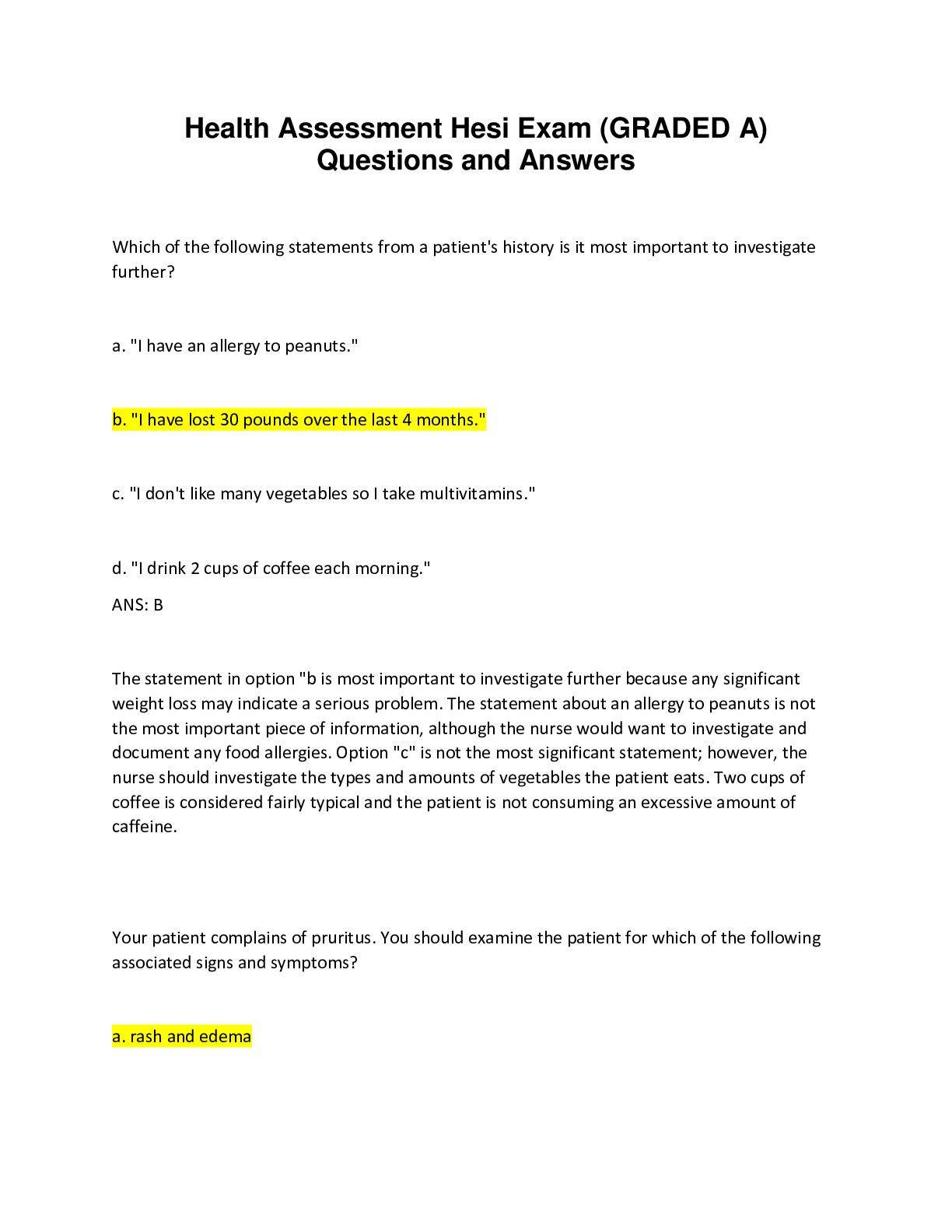
Also available in bundle (1)

HESI Health Assessment Exams and Study Materials PACKAGE DEAL (100% Guaranteed Pass
HESI Health Assessment Exams and Study Materials PACKAGE DEAL (100% Guaranteed Pass
By A+ Solutions 6 months ago
$20.5
11
Reviews( 0 )
Document information
Connected school, study & course
About the document
Uploaded On
Oct 07, 2023
Number of pages
27
Written in
Additional information
This document has been written for:
Uploaded
Oct 07, 2023
Downloads
0
Views
100


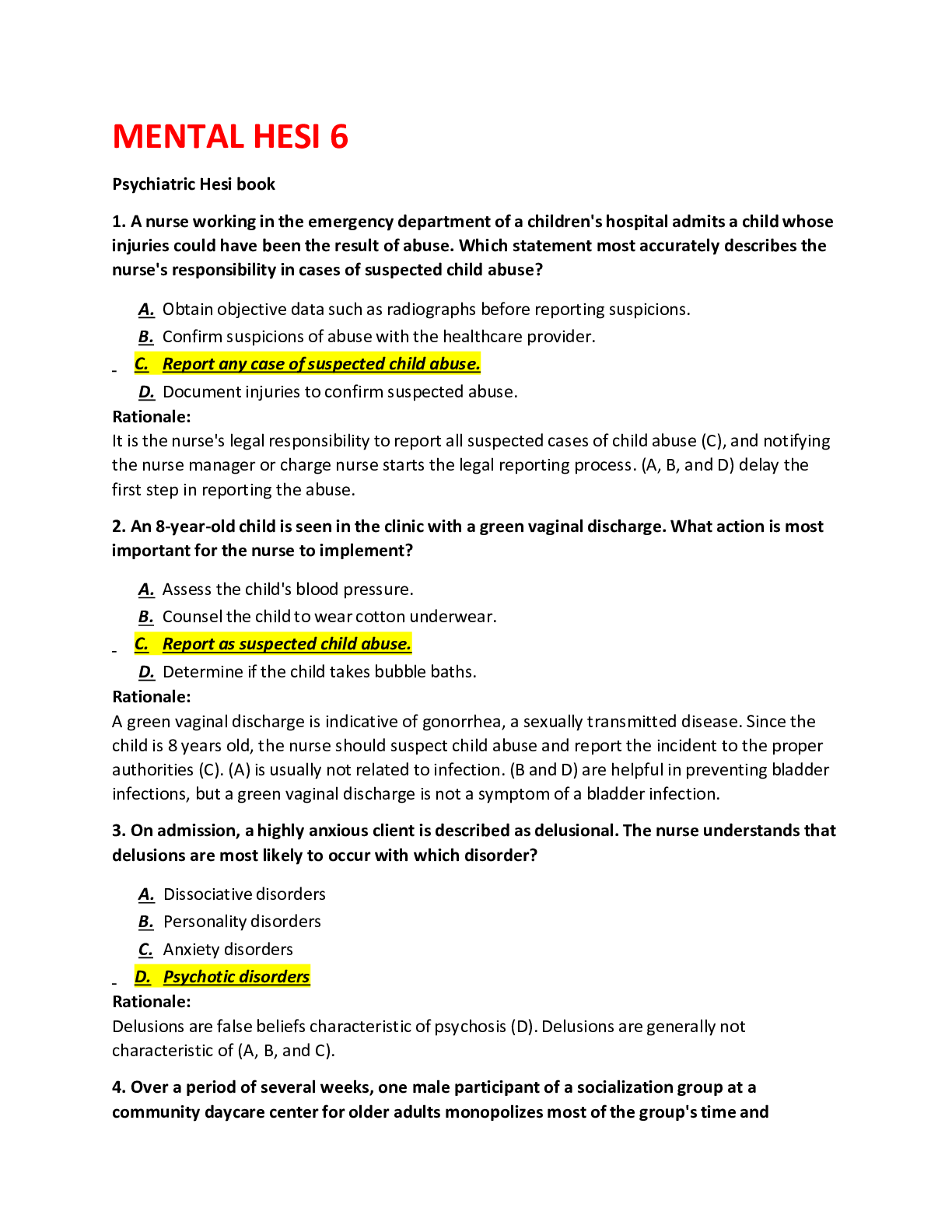
.png)


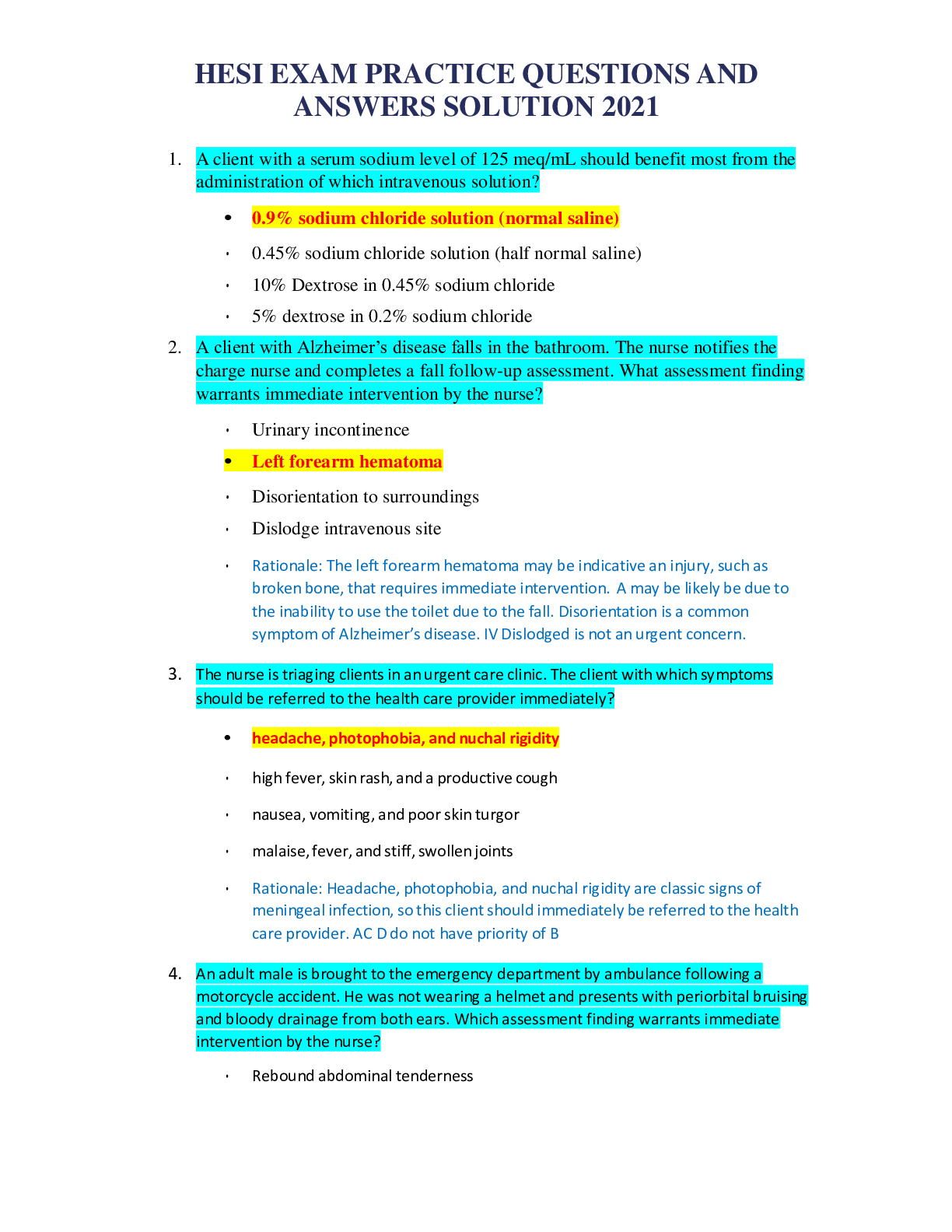
.png)
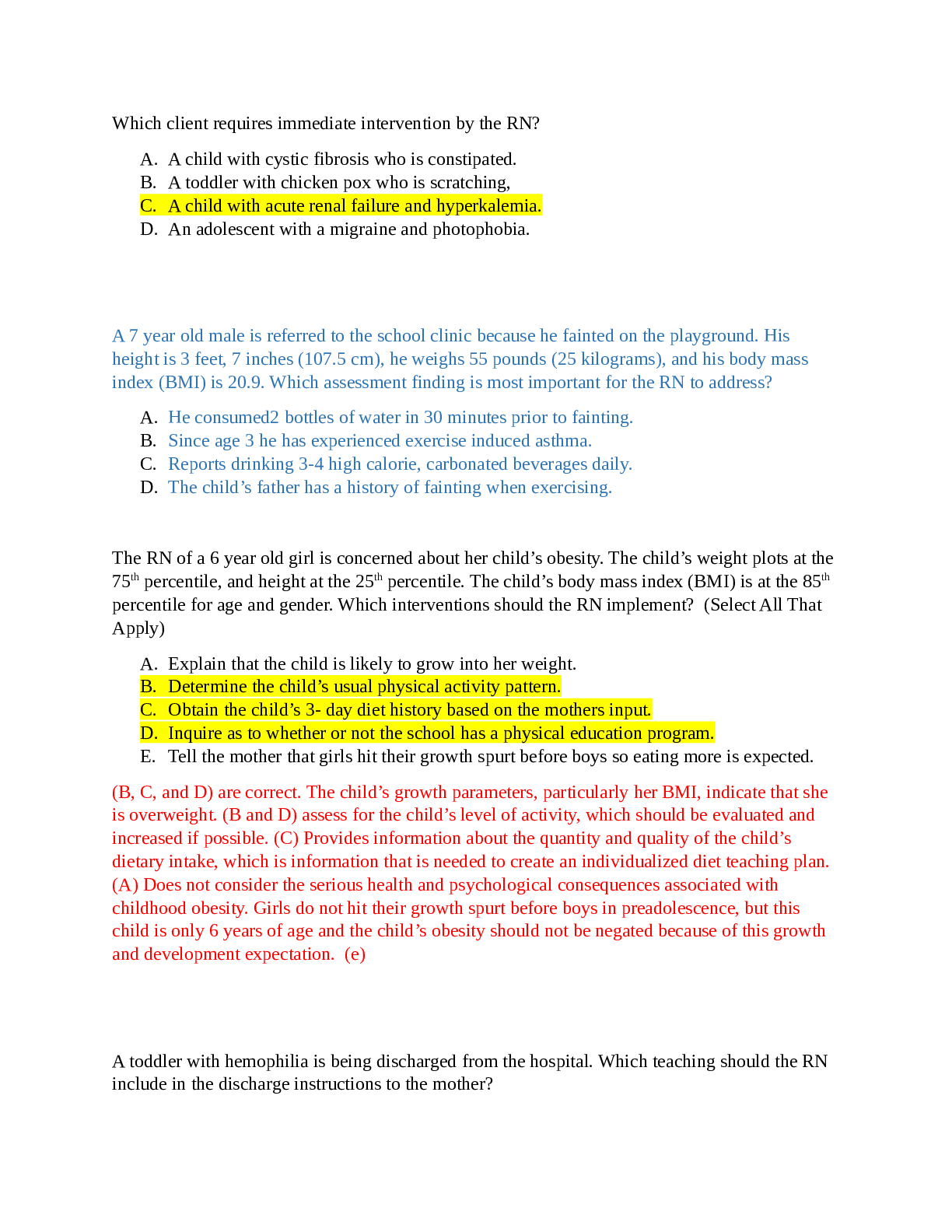



.png)
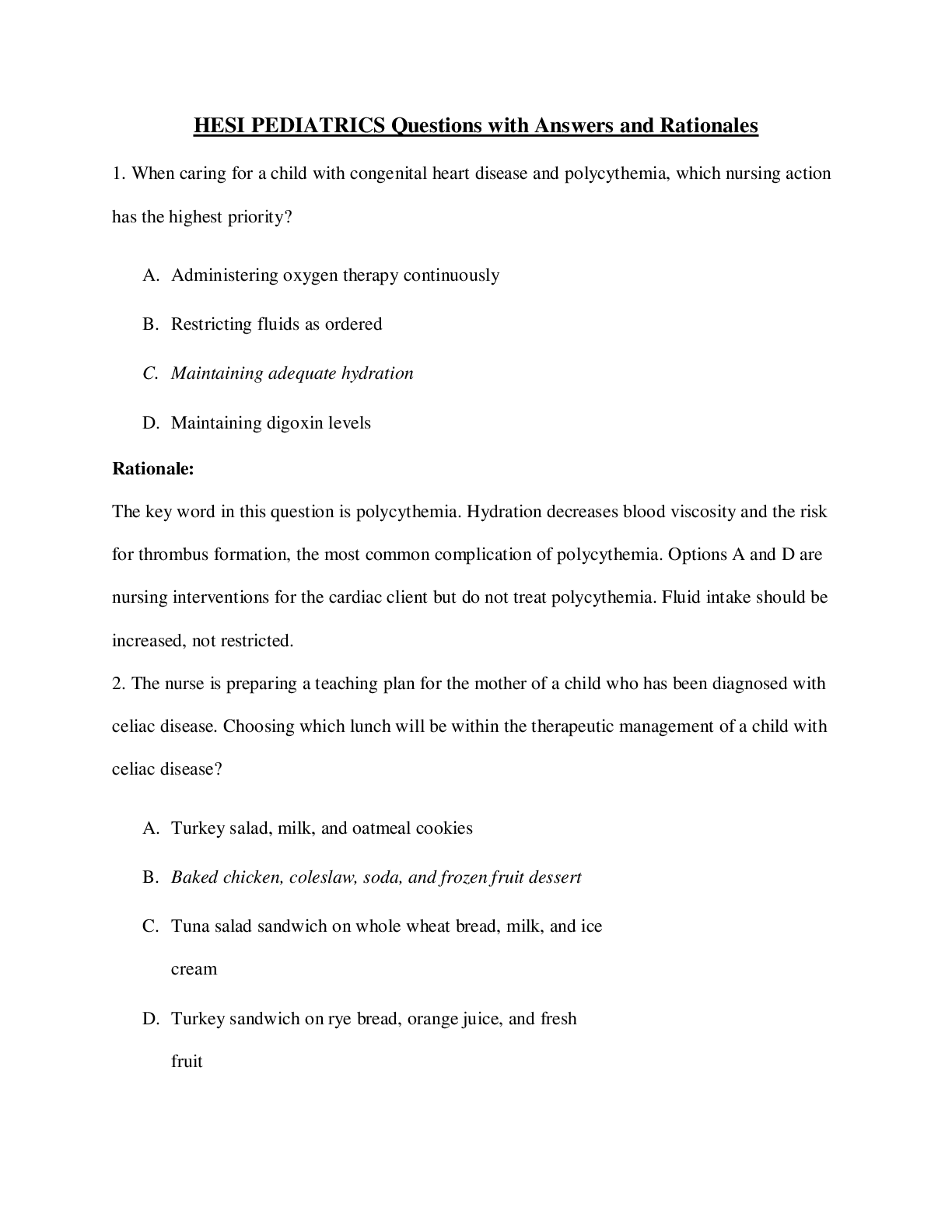
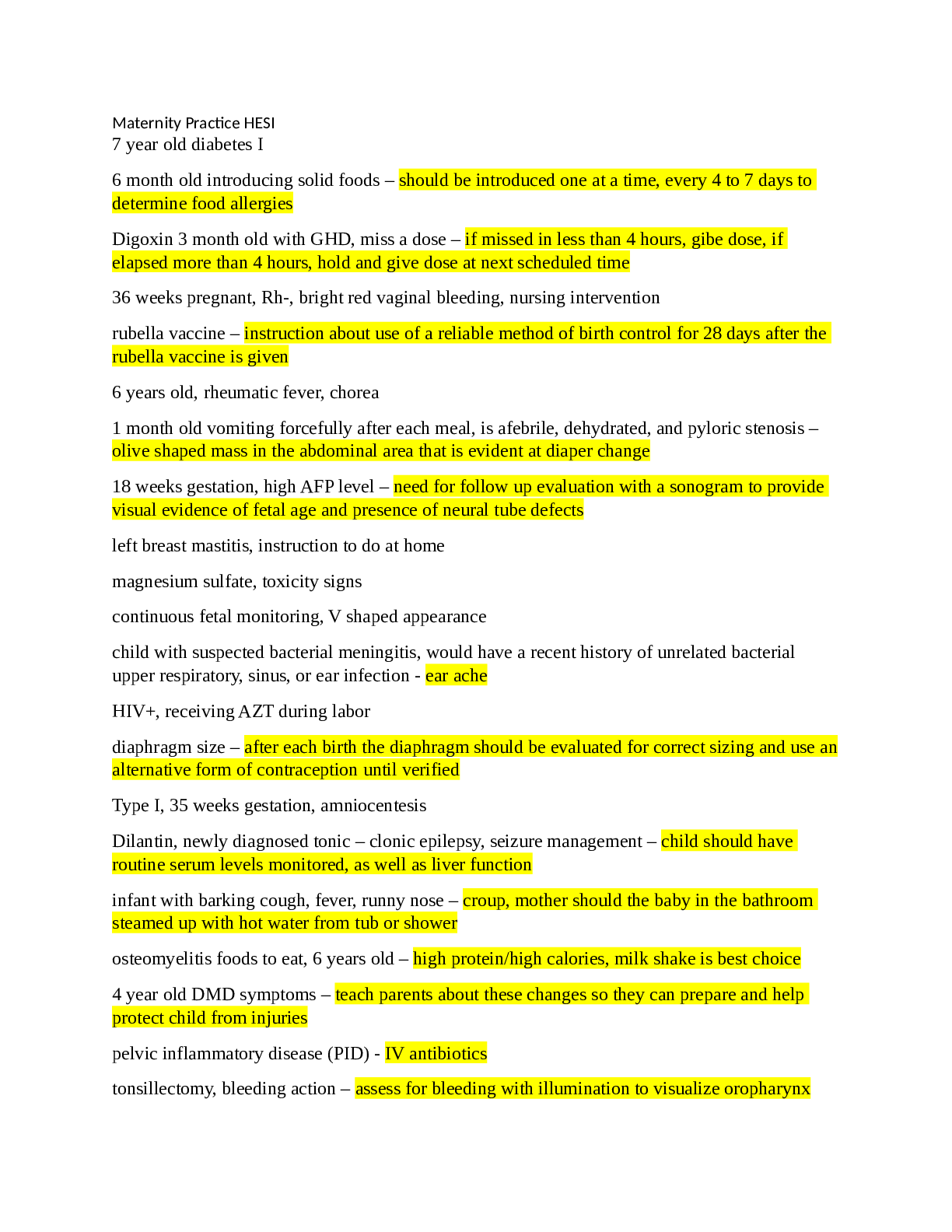

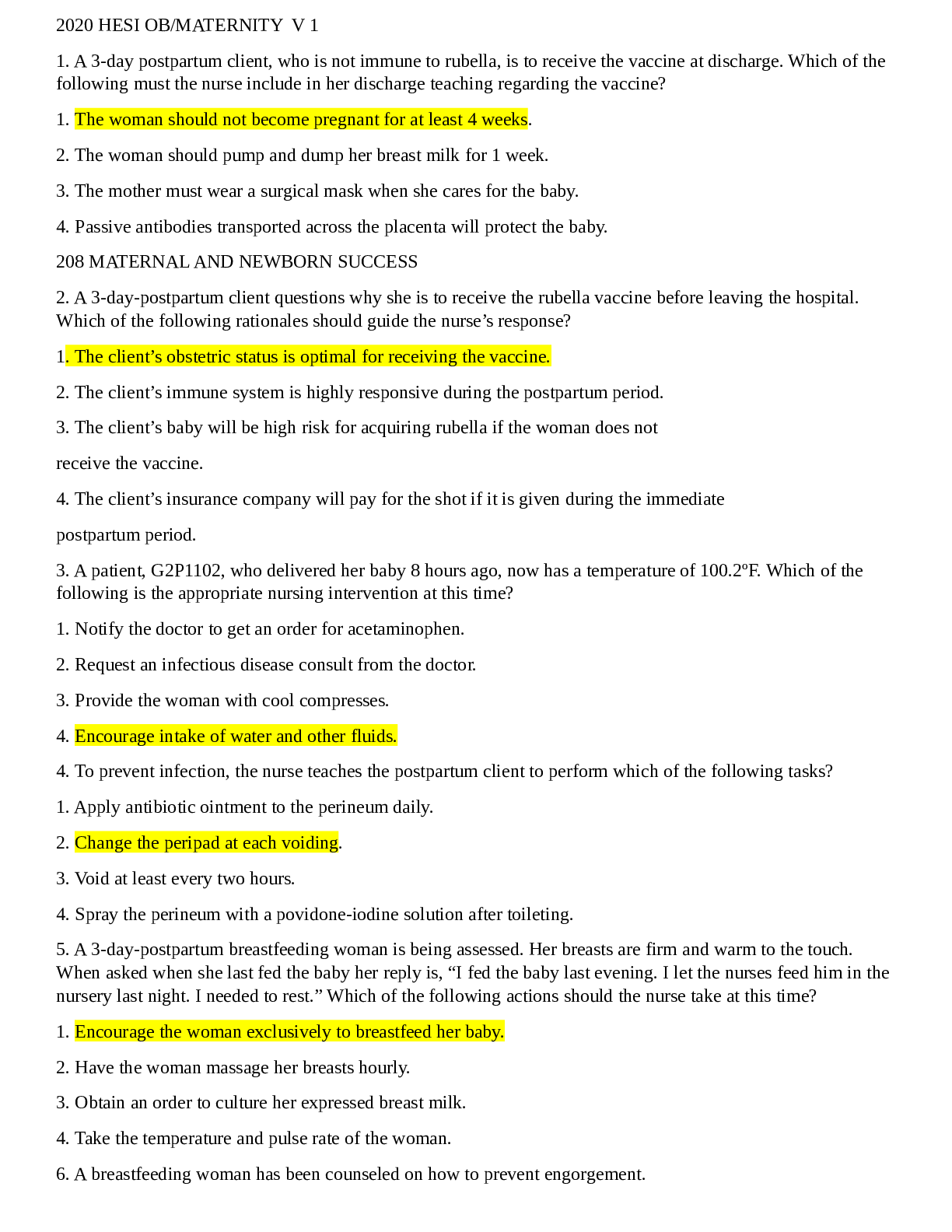
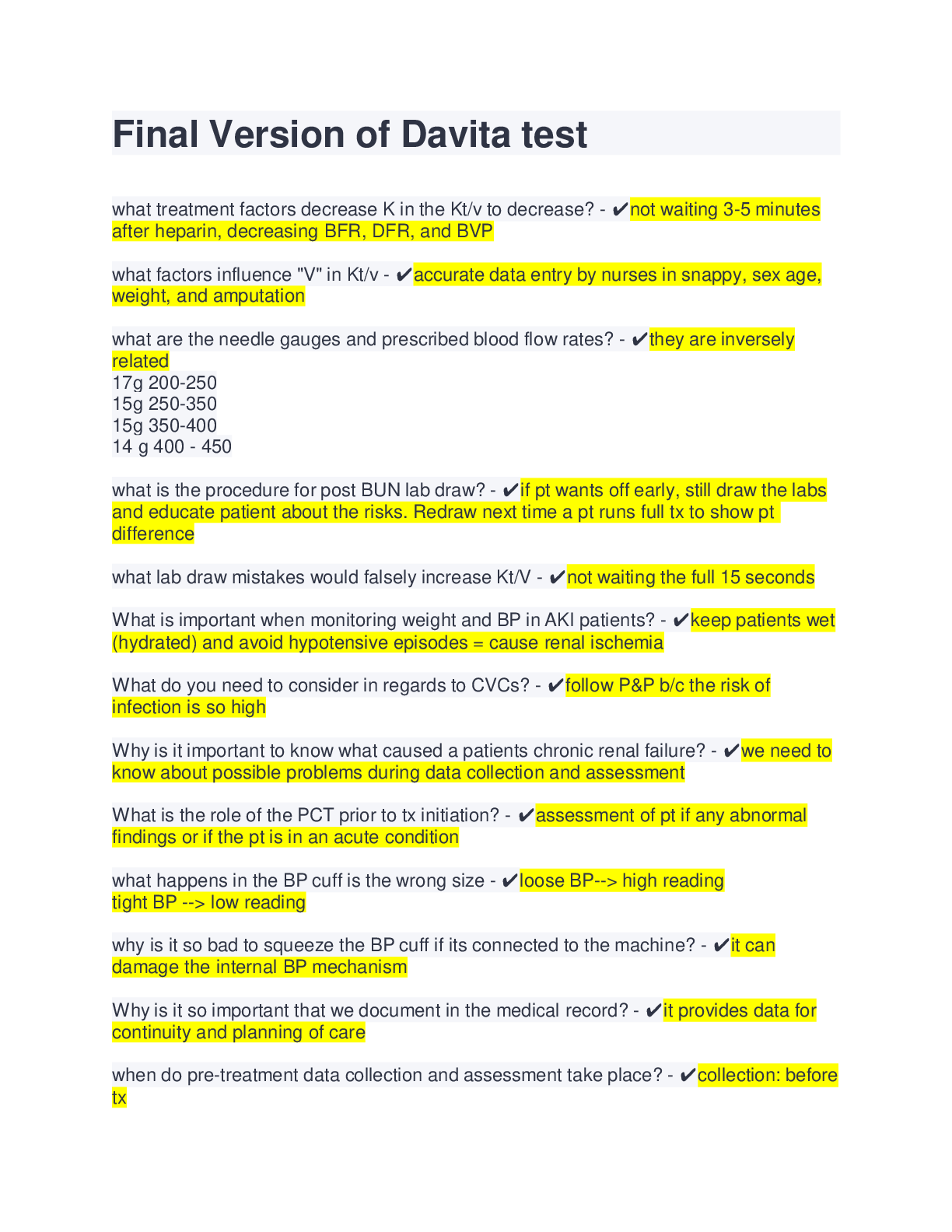
 Questions and Answers with elaborations.png)
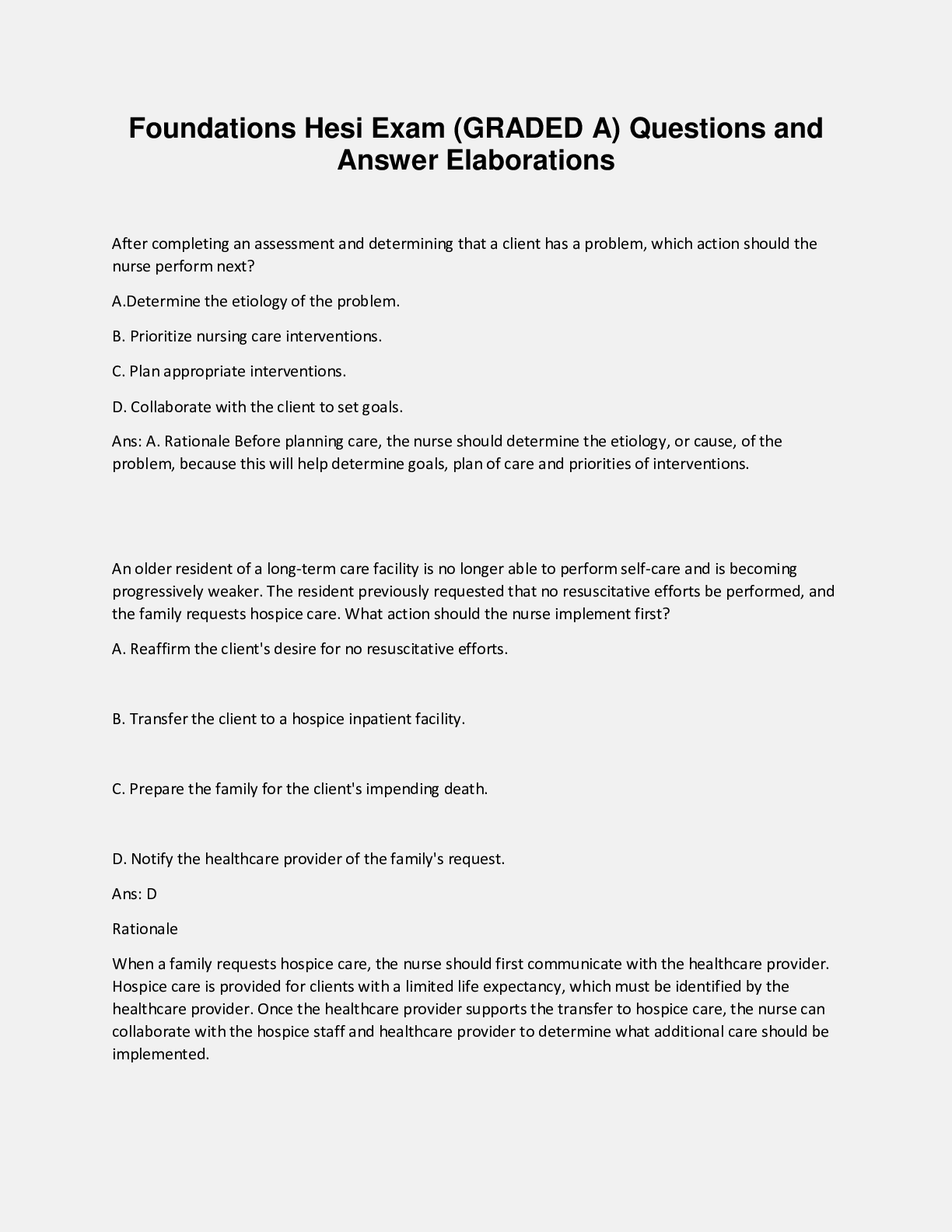




 (1).png)



